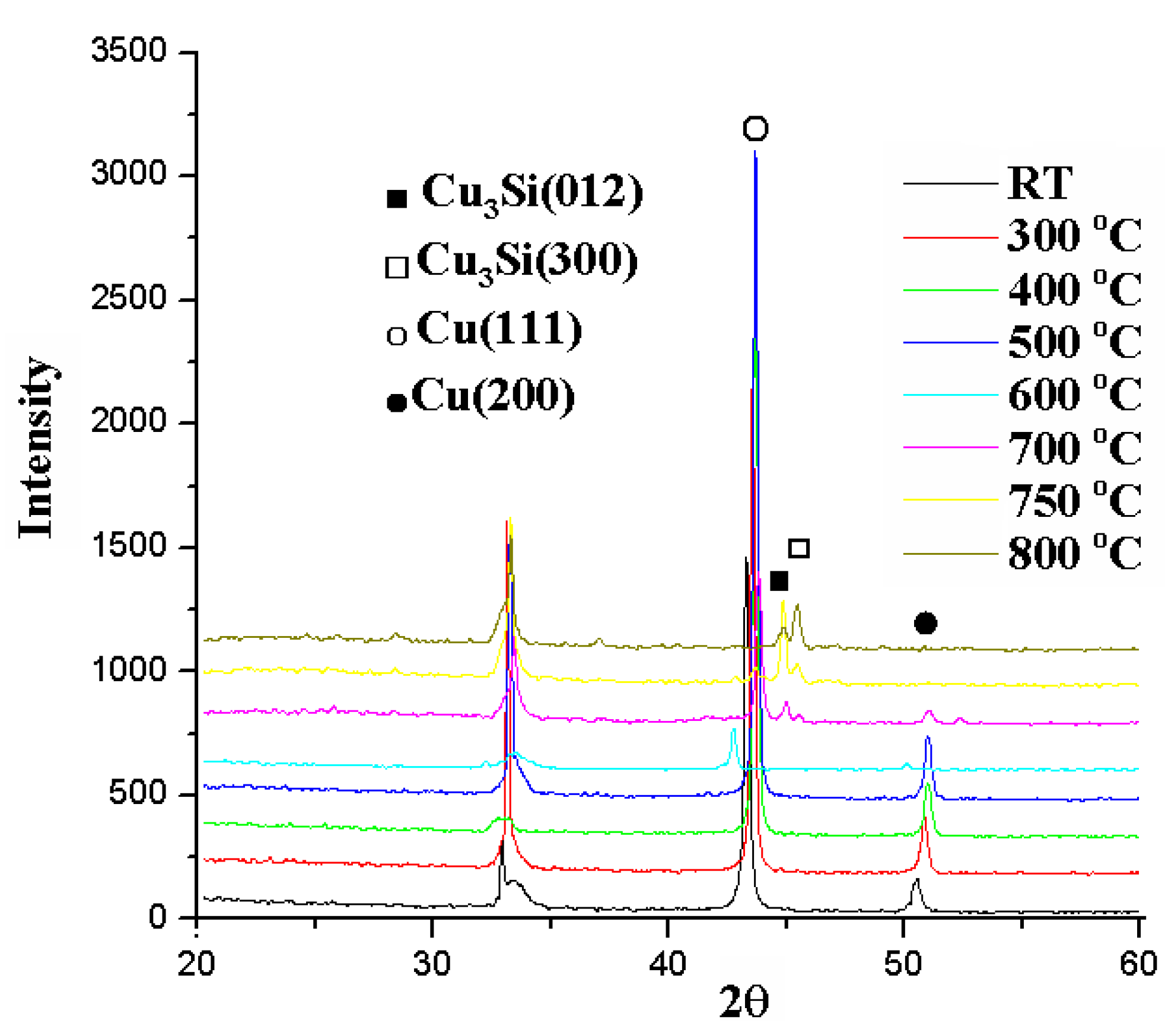Structural Stability of Diffusion Barriers in Cu/Ru/MgO/Ta/Si
Abstract
:1. Introduction
2. Results and Discussion
2.1. Cu (50 nm)/Ru (2 nm)/MgO (3 nm)/Ta (2 nm)/Si







2.2. Cu (50 nm)/Ru (2 nm)/MgO (2 nm)/Ta (2 nm)/Si



2.3. Cu (50 nm)/Ru (2 nm)/MgO (1 nm)/Ta (2 nm)/Si



2.4. Cu (50 nm)/Ru (2 nm)/MgO (0.5 nm)/Ta (2 nm)/Si



2.5. Effects of MgO Layer Thicknesses and Annealing Times on the Failure of the Diffusion Barriers
| Annealing Time | Thickness of MgO Layers | |||
|---|---|---|---|---|
| 0.5 nm | 1 nm | 2 nm | 3 nm | |
| 5 min | 550 °C | 600 °C | 750 °C | 750 °C |
| 30 min | 500 °C | 600 °C | 650 °C | 700 °C |
3. Experimental Section
4. Conclusions
Acknowledgments
Author Contributions
Conflicts of Interest
References
- Grovenor, C.R.M. Microelectronic Materials; IOP Publishing: Bristol, UK, 1998. [Google Scholar]
- Nicolet, M.A. Diffusion barriers in thin films. Thin Solid Films 1978, 52, 415–443. [Google Scholar] [CrossRef]
- Liu, W.L.; Chen, W.J.; Tsai, T.K.; Hsieh, S.H.; Liu, C.M. Effect of tin-doped indium oxide film as capping layer on the agglomeration of copper film and the appearance of copper silicide. Appl. Surf. Sci. 2007, 253, 5516–5520. [Google Scholar] [CrossRef]
- Tsai, D.C.; Huang, Y.L.; Lin, S.R.; Jung, D.R.; Chang, S.Y.; Shieu, F.S. Diffusion barrier performance of TiVCr alloy film in Cu metallization. Appl. Surf. Sci. 2011, 257, 4923–4927. [Google Scholar] [CrossRef]
- Dalili, N.; Liu, Q.; Ivey, D.G. Ta-Rh binary alloys as a potential diffusion barrier between Cu and Si: Stability and failure mechanism of the Ta-Rh amorphous structures. Acta Mater. 2013, 615, 365–374. [Google Scholar] [CrossRef]
- Yeo, S.M.; Choi, S.-H.; Park, J.-Y.; Kim, S.-H.; Cheon, T.H.; Lim, B.Y.; Kim, S.J. Atomic layer deposition of ruthenium (Ru) thin films using ethylbenzen-cyclohexadiene Ru(0) as a seed layer for copper metallization. Thin Solid Films 2013, 322, 213–217. [Google Scholar] [CrossRef]
- Raj, A.M.E.; Jayachandran, M.; Sanjeeviraja, C. Fabrication techniques and material properties of dielectric MgO thin films—A status review. CIRP J. Manuf. Sci. Tech. 2010, 2, 92–113. [Google Scholar] [CrossRef]
- Bian, J.M.; Li, X.M.; Chen, T.L.; Gao, X.D.; Yu, W.D. Preparation of high quality MgO thin films by ultrasonic spray pyrolysis. Appl. Surf. Sci. 2004, 228, 297–301. [Google Scholar] [CrossRef]
- Wu, M.C.; Corneille, J.S.; Estrada, C.A.; He, J.W.; Goodman, D.W. Synthesis and characterization of ultra-thin MgO films on Mo(100). Chem. Phys. Lett. 1991, 182, 472–478. [Google Scholar] [CrossRef]
- Larson, D.J.; Marquis, E.A.; Rice, P.M.; Prosa, T.J.; Geiser, B.P.; Yang, S.H.; Parkin, S.S.P. Manganese diffusion in annealed magnetic tunnel junctions with MgO tunnel barriers. Scr. Mater. 2011, 64, 673–676. [Google Scholar] [CrossRef]
- Corneille, J.S.; He, J.W.; Goodman, D.W. XPS characterization of ultra-thin MgO films on a Mo(100) surface. Surf. Sci. 1994, 306, 269–278. [Google Scholar] [CrossRef]
- Beiser, A. Concepts of Modern Physics, 6th ed.; McGraw-Hill: New York, NY, USA, 2003; pp. 184–186. [Google Scholar]
- Murarka, S.P. Multilevel interconnections for ULSI and GSI era. Mater. Sci. Eng. R. 1997, 19, 87–151. [Google Scholar] [CrossRef]
- Broniatowski, A. Multicarrier trapping by copper microprecipitates in silicon. Phys. Rev. Lett. 1989, 62, 3074–3077. [Google Scholar] [CrossRef] [PubMed]
- Torres, J. Advanced copper interconnections for silicon CMOS technologies. Appl. Surf. Sci. 1995, 91, 112–123. [Google Scholar] [CrossRef]
- Murarka, S.P. Advanced materials for future interconnections of the future need and strategy. Microelectron. Eng. 1997, 37/38, 29–37. [Google Scholar] [CrossRef]
- Ono, H.; Nakano, T.; Ohta, T. Diffusion Barrier Effects of Transition Metals for Cu/M/Si Multilayers. Appl. Phys. Lett. 1994, 6412, 1511–1513. [Google Scholar] [CrossRef]
- Chen, C.W.; Chen, J.S.; Jeng, J.S. Improvement on the Diffusion Barrier Performance of Reactively Sputtered Ru–N Film by Incorporation of Ta. J. Electrochem. Soc. 2008, 155, H438–H442. [Google Scholar] [CrossRef]
- Wang, S.J.; Tsai, H.Y.; Sun, S.C. A comparative study of sputtered TaCx and WCx films as diffusion barriers between Cu and Si. Thin Solid Films 2001, 394, 179–187. [Google Scholar] [CrossRef]
- Liu, C.M.; Liu, W.L.; Chen, W.J.; Hsieh, S.H.; Tsai, T.K.; Yang, L.C. ITO as a diffusion barrier between Si and Cu. J. Electrochem. Soc. 2005, 152, G234–G239. [Google Scholar] [CrossRef]
- Lin, S.T.; Lee, C.P. Characteristics of sputtered Ta–B–N thin films as diffusion barriers between copper and silicon. Appl. Surf. Sci. 2006, 253, 1215–1221. [Google Scholar] [CrossRef]
- The International Technology Roadmap for Semiconductors. Interconnect. 2013. Available online: http://www.itrs.net/ITRS%201999-2014%20Mtgs,%20Presentations%20&%20Links/2013ITRS/Summary2013.htm (accessed on 8 April 2014).
- Chan, R.; Arunagiri, T.N.; Zhang, Y.; Chyan, O.; Wallace, R.M.; Kim, M.J.; Hurd, T.Q. Diffusion studies of copper on ruthenium thin film: A plateable copper diffusion barrier. Electrochem. Solid-State Lett. 2004, 7, G154–G157. [Google Scholar] [CrossRef]
- Arunagiri, T.N.; Zhang, Y.; Chyan, O.; El-Bouanani, M.; Kim, M.J.; Chen, K.H.; Wu, C.T.; Chen, L.C. 5 nm ruthenium thin film as a directly plateable copper diffusion barrier. Appl. Phys. Lett. 2005, 86, 083104. [Google Scholar] [CrossRef]
- Holloway, K.; Fryer, P.M.; Cabral, C., Jr.; Harper, J.M.E.; Bailey, P.J.; Kelleher, K.H. Tantalum as a diffusion barrier between copper and silicon: Failure mechanism and effect of nitrogen additions. J. Appl. Phys. 1992, 71, 5433–5444. [Google Scholar] [CrossRef]
© 2015 by the authors; licensee MDPI, Basel, Switzerland. This article is an open access article distributed under the terms and conditions of the Creative Commons Attribution license (http://creativecommons.org/licenses/by/4.0/).
Share and Cite
Hsieh, S.-H.; Chen, W.J.; Chien, C.-M. Structural Stability of Diffusion Barriers in Cu/Ru/MgO/Ta/Si. Nanomaterials 2015, 5, 1840-1852. https://doi.org/10.3390/nano5041840
Hsieh S-H, Chen WJ, Chien C-M. Structural Stability of Diffusion Barriers in Cu/Ru/MgO/Ta/Si. Nanomaterials. 2015; 5(4):1840-1852. https://doi.org/10.3390/nano5041840
Chicago/Turabian StyleHsieh, Shu-Huei, Wen Jauh Chen, and Chu-Mo Chien. 2015. "Structural Stability of Diffusion Barriers in Cu/Ru/MgO/Ta/Si" Nanomaterials 5, no. 4: 1840-1852. https://doi.org/10.3390/nano5041840
APA StyleHsieh, S.-H., Chen, W. J., & Chien, C.-M. (2015). Structural Stability of Diffusion Barriers in Cu/Ru/MgO/Ta/Si. Nanomaterials, 5(4), 1840-1852. https://doi.org/10.3390/nano5041840





